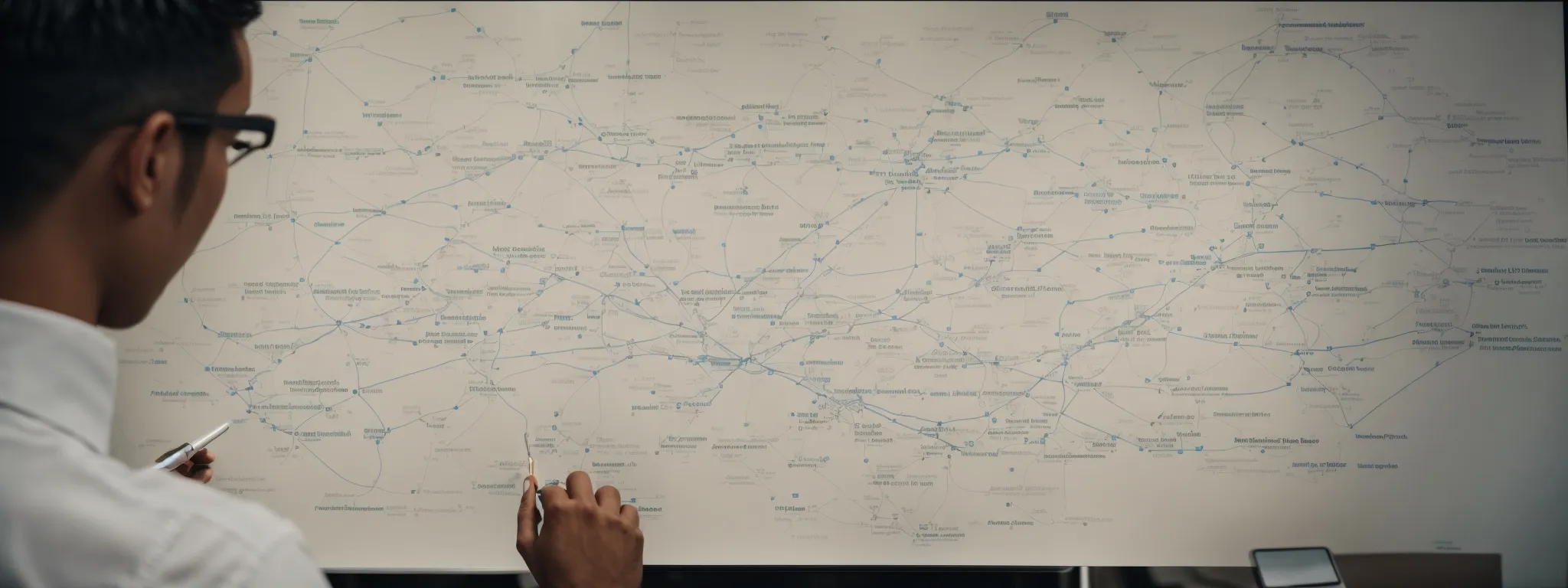What is Content Gap?
Understanding Content Gaps and Their Impact on SEO Strategy In the ever-evolving landscape of digital marketing, staying ahead in the SEO game is critical for any brand […]
Understanding Content Gaps and Their Impact on SEO Strategy
In the ever-evolving landscape of digital marketing, staying ahead in the SEO game is critical for any brand that looks to make its mark online.
A content gap analysis emerges as an essential tool, allowing companies to identify missing pieces within their content strategy that could be hindering their connection with a target audience.
By systematically evaluating existing content against the needs and queries of users, businesses can pinpoint opportunities for growth and address areas where competitors may be outperforming them.
LinkGraph’s SEO services excel in uncovering these pivotal insights, ultimately leading businesses to a richer, more engaging online presence.
Keep reading to learn how you can leverage a content gap analysis to refine your SEO strategy and enhance content performance.
Key Takeaways
- Content Gap Analysis Is Essential for Enhancing SEO Strategy and Aligning With User Intent
- Identifying and Filling Content Gaps Improve Organic Search Visibility and User Engagement
- Meticulous Market Research and Advanced SEO Tools Like Search Atlas Are Crucial for Content Strategy Optimization
- Periodic Content Audits Ensure Content Remains Relevant and SEO Strategies Stay Competitive
- After Content Gap Analysis, Recalibrating SEO Strategies With Data Insights Ensures Maximum Search Engine Impact
What Is a Content Gap Analysis?

In the ever-evolving landscape of search engine optimization, there exists an essential process pivotal for bolstering a brand’s digital presence: the content gap analysis.
This strategy involves meticulous scrutiny of a company’s existing content assets to unearth potential areas where searchers’ needs have not been fully addressed.
Examining these content voids allows businesses to refine their content creation practices, ultimately enriching the user experience and improving search rankings.
Understanding a content gap’s essence and its ramifications on the SEO realm can be transformative, extending a clearer path for content ideation and meeting the evolving expectations of a target audience.
Defining Content Gap in the Context of SEO
In the realm of SEO, a content gap signifies the chasm between a brand’s current online material and the queries or interests of its intended customer base. These disparities offer strategic keyword opportunities for a company to enhance its relevance and authority within search engine results pages (SERPs).
LinkGraph’s Expertise in conducting thorough content gap analyses aids clients in identifying underrepresented subtopics or questions that their existing web pages and landing pages do not adequately cover. This methodical examination aids in aligning a brand’s content strategy more closely with the nuanced demands of its target audience’s search intent.
The Role of Content Gap Analysis in SEO
The implementation of content gap analysis serves as a cornerstone in the formulation of a robust SEO Strategy. By harnessing this approach, LinkGraph facilitates the discovery of untapped keyword realms and aids in the creation of content pieces that can fill those gaps, thus elevating a website’s visibility and relevance in search engine results.
Moreover, this analysis fosters a deeper understanding of the buyer’s journey and customer personas, which is critical for constructing targeted SEO content that addresses the specific informational or transactional needs of the audience. LinkGraph’s dedication in this phase ensures that clients make informed decisions about their SEO investments and content marketing efforts.
Types of Content Gaps You Might Encounter
Identifying the variety of content gaps is an integral step in refining an SEO strategy. One may encounter informational gaps where content does not fully answer searchers’ queries or provide sufficient depth on a topic, leaving room for competitors to seize valuable spots on SERPs.
Another common shortfall is the lack of transactional or conversion-oriented content that effectively guides the user along the customer journey to the point of purchase, subscription, or other desired actions. LinkGraph’s seasoned experts specialize in unveiling these areas, facilitating a content structure that nurtures leads and fosters conversions.
Mapping Your Content to the Buyer’s Journey

Within the ambit of search engine optimization, understanding and aligning content with the buyer’s journey is not merely a matter of crafting engaging narratives—it’s about comprehensively covering each stage of the customer journey.
This harmonization ensures potential customers find relevant content from the awareness phase through to decision-making.
Professionals in the field recognize the significance of assessing and identifying missing content at these pivotal junctures, as these lapses can impede the progress of a buyer along their journey.
Astute alignment of an SEO strategy with this journey empowers businesses to fine-tune their content marketing and SEO efforts, optimizing each touchpoint to the buyer’s evolving needs.
Identifying Missing Content at Each Stage
At the outset of content gap analysis, LinkGraph meticulously identifies the missing elements in a company’s online narrative. This begins with dissecting the various stages of the buyer’s journey: awareness, consideration, and decision:
- Awareness: Scanning for topical gaps or incomplete introductions to the client’s industry, product, or service.
- Consideration: Evaluating mid-funnel content to ensure it addresses comparisons and validates the client’s offerings against potential alternatives.
- Decision: Ensuring that the closing stages are replete with persuasive calls-to-action and robust content that facilitates customer conversion and loyalty.
The granularity of this process reveals the checkpoints where a potential customer may sidestep the path to purchase. By pinpointing these gaps, LinkGraph crafts strategic content tailored to guide the user seamlessly from one stage to the next.
How Content Gaps Affect the Buyer’s Journey
Content gaps create a jarring interruption in the seamless flow of the buyer’s journey, often resulting in the potential customer’s disengagement. When a user encounters missing or inadequate information, it impedes their move from awareness to decision, compromising the trust and credibility associated with the brand.
LinkGraph’s expertise lies in bridging these content voids, ensuring every phase of the customer journey is underpinned with targeted, resonant content. Through strategic SEO services, LinkGraph transforms potential obstacles into smooth transitions within the customer journey, augmenting the likelihood of user retention and conversion.
Aligning SEO Strategy With the Buyer’s Journey
Customization of an SEO strategy to cater to the buyer’s journey necessitates keen insight into the customer’s progression at each phase. LinkGraph recognizes the crucial need to optimize content that not only attracts but also retains visitors, guiding them down the funnel from initial awareness to the final commitment with utmost precision.
Through the application of sophisticated SEO Tools Like Search Atlas, LinkGraph tailors each web page to speak directly to the varied steps in the buyer’s pathway. This approach ensures that each piece of content delivered is a stepping stone towards fostering a deeper connection between the reader and the brand, leading to an increased probability of conversion and customer loyalty.
4 Steps to Conducting a Content Gap Analysis

Embarking on a content gap analysis encompasses a series of methodically executed steps, each pivotal in sculpting a seamless SEO strategy that resonates with the buyer’s journey.
The sequence initiates with charting the buyer’s course, progresses through in-depth market research, scrutinizes the client’s web presence, and culminates with a comparative analysis of competitors’ content.
This comprehensive procedure empowers LinkGraph to curate customized SEO services that not only illuminate overlooked content opportunities but also strengthen the client’s competitive edge in the digital market.
The forthcoming exploration into these four stages will unravel the intricacies of content gap analysis and its profound impact on a company’s online strategy.
1. Map Out Your Buyer’s Journey
Charting the buyer’s journey forms the bedrock of a meticulous content gap analysis, with LinkGraph’s strategic approach designed to understand and cater to every nuanced stage of the buyer–from initial awareness to final decision. This mapping delves into the customer’s mindset, discerning their informational requisites and aspirations at each critical juncture of the journey.
Through this finely-tuned approach, LinkGraph’s SEO services illuminate the roadmap of the buyer’s interactions and considerations, transforming abstract data into actionable insights that directly influence content strategy. Identifying where the target audience seeks knowledge, compares options, and makes purchasing decisions allows for the creation of targeted content that effectively addresses potential pain points:
| Buyer’s Journey Stage | Customer Need | Content Objective |
|---|---|---|
| Awareness | Seeking information | Provide educational content that highlights the problem |
| Consideration | Comparing solutions | Craft content that differentiates the product or service |
| Decision | Ready to purchase | Develop persuasive content that encourages conversion |
2. Conduct Market Research
After mapping the buyer’s journey, LinkGraph progresses to rigorous market research. This step involves a deep dive into search trend data and user behavior to comprehend the prevailing search intent and discover content ideas that resonate with the target audience.
Exhaustive analysis of search volumes, keyword relevance, and SERP features using sophisticated SEO tools like Search Atlas enables LinkGraph to pinpoint high-potential content opportunities and craft a data-backed SEO content strategy.
| Content Gap Analysis Stage | Objective |
|---|---|
| Market Research | Analyze search trends and user behavior to align content with search intent and audience needs |
3. Analyze the Content on Your Website
An essential step in content gap analysis is the meticulous examination of a company’s existing online material. LinkGraph expertly scrutinizes each web page to ensure that content matches the intent and needs of its audience, highlighting any deficits that may hinder content performance.
Detecting underutilized content or areas lacking SEO optimization is crucial in this analysis. LinkGraph employs comprehensive content audits, leveraging tools like Search Atlas, to measure the effectiveness and relevance of all on-site content, identifying key areas for improvement and expansion.
4. Analyze Your Competitors’ Content
Analyzing competitors’ content is a critical step in a comprehensive content gap analysis. LinkGraph employs a multi-faceted approach to discern the Content Strategies that competitors are using to captivate similar target audiences, identifying which topics and keyword realms they have successfully owned.
This competitive insight paves the way for LinkGraph to craft actionable plans for content creation, aimed at claiming key spots within SERPs and establishing unique value propositions for the client’s brand. The subsequent table depicts the focus areas and benefits of this Competitive Analysis:
| Competitor Analysis Focus Area | Benefit to Client’s SEO Strategy |
|---|---|
| Identifying Competitor Keyword Strengths | Possible realignment of target keyword strategy to capture’low-hanging fruit’ and overlooked niche markets. |
| Evaluating Competitor Content Quality and Structure | Enhanced content performance through superior content ideas and structural improvements. |
| Link Building Strategies Used by Competitors | Adoption and refinement of link building practices to improve site authority and ranking potential. |
The Impact of Content Gaps on SEO Performance

Identifying and addressing content gaps stands as a critical component in the optimization of an SEO strategy, as neglecting these areas can significantly detract from a brand’s online prominence and rankings.
Firmly rooted in the detection of these elusive gaps is the understanding that content serves not just as information but as an experience for the user, a journey that engages and answers their queries throughout their digital exploration.
As businesses meticulously analyze and bridge these voids, they unlock substantial opportunities for enhancing their SEO performance—reinforcing user experience, fostering engagement, and solidifying their authority in the digital domain.
How Unaddressed Content Gaps Can Hurt Rankings
Unaddressed content gaps can severely impede a website’s ability to ascend the search engine rankings. By not fully accounting for the myriad of queries and topics relevant to an audience, a website may surrender valuable search positions to competitors who exhibit a more comprehensive digital footprint.
Furthermore, gaps in content lead to missed connections with searchers, diminishing the perceived expertise, authority, and trustworthiness of a brand. This paucity of information can directly affect a site’s SEO prospects, as search engines prioritize content that satisfies user intent and provides a thorough exploration of subjects.
The Relationship Between Content Gaps and User Experience
The quality of user experience hinges on a website’s ability to provide comprehensive and relevant content that aligns with user needs. When content gaps are present, visitors may encounter frustrating dead ends, which can tarnish brand reputation and deter repeat visits.
LinkGraph understands that enhancing user experience goes hand in hand with addressing content inadequacies. By proactively filling these gaps, the company ensures that users remain engaged, well-informed, and more likely to convert, thus reinforcing the client’s SEO positioning and online authority.
Leveraging Content Gaps to Improve SEO Outcomes
LinkGraph adeptly transforms content gaps into strategic avenues for amplifying a brand’s SEO success. By equipping clients with advanced SEO services, they ensure that newly uncovered keyword realms and user-centric content ideas not only fill the omissions but drive increased organic traffic and bolster domain authority.
Through the tactical use of Search Atlas, LinkGraph identifies and capitalizes on content vacancies, enriching the visitor’s experience and enhancing site relevance. This cultivated approach accentuates a website’s presence in SERPs, leveraging gaps as opportunities to outpace competitors and foster sustained Digital Growth.
Bridging Content Gaps to Boost Organic Reach

In an unforgiving digital arena where organic visibility is the cornerstone of success, recognizing and rectifying content gaps is not just prudent; it’s essential for an effective SEO strategy.
Astutely filling these gaps necessitates discerning strategies that link closely with audience needs and search trends while faithfully aligning with the brand’s vision.
Quantifying the influence of gap mitigation efforts can shed light on the remarkable capacity such initiatives have to magnify organic reach and secure a competitive edge.
Progressive companies have harnessed these insights, and through various case studies, they paint a vivid picture of triumph where effectively bridged content gaps have yielded dividends in organic search performance and user engagement.
Strategies for Filling Content Gaps
Initiating strategic partnerships with LinkGraph, clients expedite the process of filling content gaps by leveraging tailor-made SEO services. Employing a conscientious blend of keyword research and content ideation, LinkGraph propels brands to discover and develop content topics that align perfectly with user searches while reinforcing brand expertise and authority.
By enlisting LinkGraph’s SEO services, clients can transform their virtual landscapes, offering relevant and engaging content that speaks to the heart of user needs. This approach addresses Content Deficiencies, ensuring that every piece of content not only resonates with the target audience but also contributes significantly to enhancing organic search visibility and elevating SEO results.
Measuring the Impact of Content Gap Mitigation
Assessing the results of content gap mitigation is a pivotal aspect of LinkGraph’s client services, where the focus is on yielding tangible SEO enhancements. The impact is quantifiable through metrics such as improved rankings for target keywords, increased organic traffic, and a higher rate of user engagement, all indicators of a successful SEO content strategy.
Monitoring changes in key performance indicators, LinkGraph’s team can validate the efficacy of the implemented Content Gap Solutions. This evaluation highlights the direct correlation between strategic gap resolution and the uplift in the brand’s search engine visibility, cementing the company’s commitment to data-driven SEO excellence.
Case Studies: Successful Content Gap Strategies
LinkGraph’s portfolio of success stories serves as a testament to the power of comprehensive Content Gap Strategies. One illustrative example saw a client’s web page ascend to the top tier of SERPs following a targeted overhaul where detected content gaps were meticulously addressed, resulting in a 150% leap in organic traffic within just months of implementation.
Another case involved a B2B client facing stagnation in search engine rankings despite a technically sound SEO foundation. Through LinkGraph’s astute content gap analysis and the subsequent enrichment of strategic content pieces, the client noted a significant improvement not only in SERP positions but also in user engagement and conversion rates, validating the potency of well-executed content gap strategies in achieving SEO objectives.
Integrating Content Gap Analysis Into SEO Planning

Embarking on an in-depth content gap analysis is a crucial exercise for those committed to refining their SEO approach.
Businesses seeking to enhance their digital presence typically integrate periodic content audits within their ongoing SEO planning to keep pace with the dynamic nature of search algorithms and user behavior.
Utilizing an arsenal of advanced tools and resources, such as LinkGraph’s Search Atlas, companies can potentiate their strategies based on data-driven insights, ensuring their content remains aligned with audience needs and search engine criteria.
The recalibration of SEO strategies post content gap analysis is an inevitable and valuable step towards maintaining a resilient and competitive online presence.
Incorporating Periodic Content Audits for Gap Analysis
Incorporating periodic content audits into the SEO planning process is vital for any company that values up-to-date and effective online strategies. These audits facilitate a regular examination of all on-site material to ensure ongoing relevancy and the highest standards of quality and user experience.
- Utilize advanced SEO tools to conduct thorough content audits and pinpoint potential gaps.
- Assess the alignment of current content with user search intent and behavior patterns.
- Implement content updates and enhancements based on audit findings to maintain optimal SEO performance.
Through diligent content audits, LinkGraph enables businesses to sustain a proactive approach to SEO, readily identifying content voids and ensuring their digital resources continually meet the sophisticated demands of search engines and users alike.
Tools and Resources for Effective Content Gap Analysis
To conduct a content gap analysis with precision, professionals rely on a suite of sophisticated tools capable of distilling data into actionable insights. LinkGraph’s Search Atlas stands as a premier example, providing an expansive outlook on keyword performance, searcher intent, and competitive benchmarks to finely tune content strategies.
Search Atlas acts as both compass and map in the terra incognita of digital content landscapes, empowering LinkGraph’s analysts to navigate the intricate SEO terrain and unearth hidden content opportunities. Its comprehensive analytics and reporting features streamline the content audit process, ensuring each client’s strategy is primed for maximum search engine impact.
Adapting SEO Strategies Post Content Gap Analysis
Post content gap analysis, a recalibration of LinkGraph’s SEO strategies involves reframing content priorities and realigning keywords to target unaddressed areas critical for user experience:
| SEO Adjustment | Strategic Focus | Predicted Outcome |
|---|---|---|
| Keyword Realignment | Target underrepresented search queries | Attain higher SERP positions for niche topics |
| Content Enhancement | Improve depth and breadth of existing content | Boost user engagement and dwell time |
| Structural Optimization | Revitalize web page architecture for better crawlability | Facilitate search engine indexing and improve visibility |
This adaptive approach ensures that each SEO maneuver is backed by empirical data harvested during the gap analysis, making the strategy responsive to the fluid dynamics of search engine algorithms and user behavior.
Conclusion
Understanding content gaps is fundamental for a successful SEO strategy.
By identifying areas where a brand’s content fails to meet user needs, businesses can target untapped keyword opportunities, enhance user experience, and improve search engine rankings.
Content gap analysis involves examining a brand’s existing digital assets, aligning content with the buyer’s journey, and identifying where improvements are necessary, particularly in comparison to competitors.
Employing tools like LinkGraph’s Search Atlas enables businesses to execute this analysis effectively.
Filling these gaps results in content that resonates with audiences, addressing their search queries and leading to increased organic traffic and conversion rates.
It also prevents competitors from capturing these missed opportunities.
Regular content audits and subsequent strategy adjustments post-analysis ensure a brand’s content stays relevant and competitive.
In essence, recognizing and bridging content gaps not only boosts a website’s SEO performance but also solidifies its authority and reach in the digital marketplace.















































































